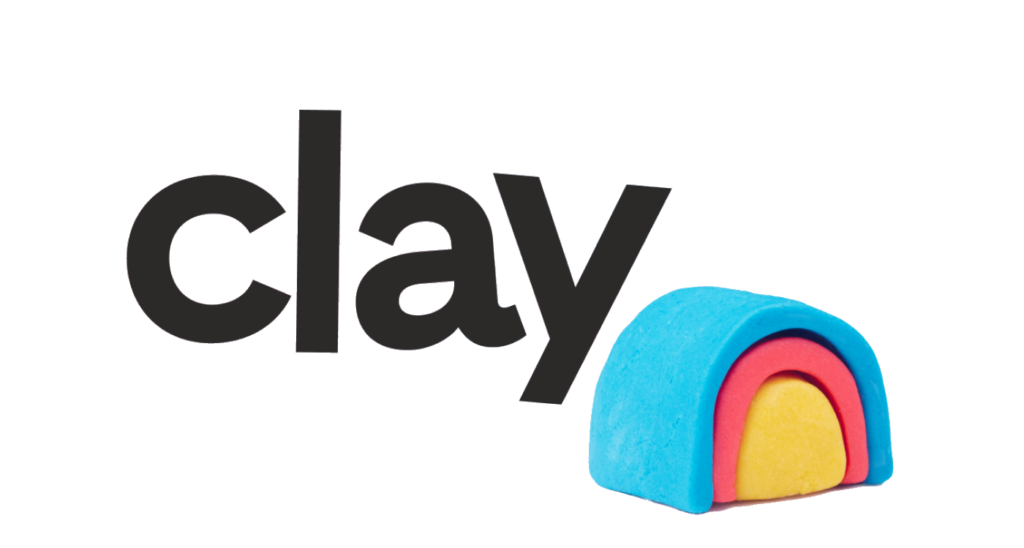Clay
Connect Clay’s data enrichment and automation with Webflow to build personalized, dynamic landing pages at scale — automate content updates and sync enriched data to CMS collections, no code required.

How to integrate Clay with Webflow
Clay transforms how you manage dynamic content in Webflow by automating data flows between your enrichment workflows and CMS collections.
Choose between the official Clay app for visual, no-code setup, native automation features for quick connections, or build custom integrations using both platforms' APIs for advanced use cases like real-time personalization and multi-source data orchestration.
Use the Clay app
The Clay app enables seamless, no-code management of your Webflow CMS collections directly from Clay tables. With this integration, you can automate the creation, updating, and bulk management of CMS items by visually mapping Clay data to Webflow fields.
The app supports conditional logic, real-time sync, and bulk actions, empowering marketers and designers to launch and personalize landing pages at scale without developer support.
Implementation
- Install and authorize the Clay app. Install the Clay app from the Webflow Apps panel and authorize your Webflow account to enable integration.
- Connect and select the right Webflow site. In Clay, connect your Webflow account, select your target site, and choose the CMS collection you want to manage.
- Map Clay data to Webflow fields. Visually map columns from your Clay table to the corresponding fields in your Webflow collection, including text, images, and custom fields.
- Automate and sync content. Use Clay to create, update, or bulk manage CMS items.
Setup takes minutes: authenticate your Webflow account in Clay, select your site and collection, then map data fields visually. The app handles all API communication, letting marketers and designers work independently without developer support.
Native features and automations
Use Clay’s native integration and automation tools to connect with Webflow for seamless data enrichment, CMS management, and real-time updates—no coding required. This method is ideal for automating landing page creation, updating CMS collections, and syncing data between platforms using Zapier, Make, or direct webhooks.
Implementation:
- Set up Clay and connect data sources. Create a Clay account and connect your data source (e.g., Google Sheets or CRM). Populate your data source with the content or records you want to sync with Webflow.
- Authenticate and link Webflow. In Clay, select the Webflow integration and authenticate your Webflow account. Choose the target Webflow project and CMS collection for automation.
- Map fields and configure automation. Map fields from your data source to Webflow CMS fields. Set up automation using Zapier, Make, or Clay’s built-in triggers to create, update, or enrich CMS items based on data changes.
- Test and activate workflow. Run a test to verify data sync and enrichment. Activate the automation for ongoing, real-time updates or scheduled bulk actions between Clay and Webflow.
Build with Webflow and Clay APIs
Direct API integration unlocks capabilities beyond pre-built connectors, enabling custom data flows, advanced personalization logic, and enterprise-scale automation. This approach suits teams with specific requirements around data processing, multi-tenant architectures, or complex enrichment chains.
Clay's API provides programmatic access to tables, enrichment actions, and workflow triggers, while Webflow's CMS API enables full control over collections, items, and publishing states. Together, they support sophisticated use cases that standard integrations can't handle.
Core capabilities include:
- Bi-directional data sync with custom field mapping and transformation
- Real-time enrichment triggers based on visitor behavior or form submissions
- Multi-source data orchestration combining Clay enrichments with other systems
- Custom authentication flows for gated content based on enriched profiles
Dynamic ABM landing pages at scale
Automatically generate and personalize hundreds of landing pages for target accounts by integrating enriched account data, dynamic content, and seamless publishing. Ensure each page is tailored with account-specific messaging, relevant proof, and clear calls to action, all aligned with sales outreach for maximum conversion.
Steps:
- Centralize and enrich account data in Clay. Import and organize target account data in Clay, including company name, industry, pain points, and use Clay’s enrichment features to add logos, employee counts, and recent news for deeper personalization.
- Design modular, dynamic templates in Webflow. Create a Webflow template collection with dynamic fields and modular sections (e.g., personalized headlines, industry-specific messaging, proof modules) to enable scalable, account-specific personalization.
- Map and personalize content for each account. Use personalization tokens and dynamic content blocks to insert account-specific details (company name, sector, pain points, relevant case studies, and tailored CTAs) into the template, ensuring message match and relevance.
- Automate publishing and align with sales outreach. Push personalized pages to Webflow via API (
POST /collections/{collection_id}/items), ensure mobile optimization, and capture engagement signals for sales follow-up. Test and iterate using analytics and A/B testing for ongoing improvement.
The Clay University guide on programmatic landing pages details field mapping and template strategies. For the Webflow side, reference the Collections API documentation for schema requirements and rate limits.
Real-time lead enrichment
Instantly enrich Webflow form submissions with company and contact data using Clay. Automate data capture, enrichment, and CMS updates for streamlined lead management.
Implementation:
- Configure your Webflow forms and webhook. Set up your Webflow form with the required lead fields and configure a webhook to trigger on submission. Ensure the webhook sends data to Clay for processing.
- Create your Clay account and connect integrations. Sign up for Clay, authenticate your Webflow account, and connect any additional data sources (e.g., CRM, Google Sheets) needed for enrichment. Map form fields to Clay table columns.
- Automate waterfall enrichment. Configure Clay to run waterfall enrichment using multiple data providers.
- Update your Webflow CMS with enriched data. Use Clay’s integration to
PATCHenriched data back to the relevant Webflow CMS collection item. Validate updates and test the workflow for accuracy and completeness.
Clay's waterfall enrichment finds the best data across 75+ sources. The Webflow Forms API provides submission data access for processing.
Automated content freshness
Automatically keep directories and resource pages up-to-date by scheduling workflows to detect changes, comparing live data with CMS items, updating or archiving as needed, and monitoring performance for ongoing freshness.
Implementation:
- Schedule automated workflows to detect data changes. Set up Clay workflows to regularly pull live data and identify updates or removals in source directories and resource pages.
- Compare and validate against existing CMS items. Match incoming data with CMS items using unique identifiers to detect new, changed, or missing entries. Validate for accuracy and relevance.
- Update or archive content automatically. Use the update endpoint to refresh stale items and set the archived flag for outdated entries, ensuring only current information is displayed.
- Monitor and audit content freshness. Track performance metrics (e.g., traffic, engagement, update frequency) using analytics tools to ensure ongoing relevance and identify further update needs.
This pattern works well for company directories, partner pages, or any content that changes frequently. Use Clay's monitoring capabilities with Webflow's item update endpoints for seamless synchronization.
What you can build
Integrating Clay with Webflow enables data-driven web experiences that adapt to your audience automatically.
- Personalized ABM microsites: Create unique landing pages for each target account featuring their logo, industry-specific messaging, and tailored value propositions pulled from Clay's enrichment data
- Dynamic company directories: Build searchable databases of businesses that auto-update with fresh firmographic data, recent funding rounds, and employee counts from Clay's data providers
- Lead-enriched contact forms: Enhance basic form submissions with complete company profiles, enabling instant lead scoring and routing based on enriched attributes like company size and technology stack
- Self-updating resource centers: Maintain partner pages, integration galleries, or customer showcases that refresh automatically as Clay monitors changes in your ecosystem
Frequently asked questions
Clay uses OAuth for secure Webflow account linking; authorize via Clay’s integration settings. For API workflows, store your Webflow API token in Clay’s environment variables—never expose tokens in client-side code.
Webflow CMS allows up to 2,000 items (standard) or 10,000 (enterprise) per site, with 60 API requests/minute. Use Clay’s batch processing and schedule updates to avoid rate limits.
Yes. Provide HTTPS-hosted image URLs in Clay; Webflow will fetch and cache these during CMS item creation or update. Ensure images are optimized for best results.
Use Clay’s 'Get collection item' with a unique identifier (e.g., email or domain) before creating items. Map external IDs and leverage Webflow’s slug field for deduplication.
Firmographic (size, industry), technographic (tools), and intent signals (news, jobs) from Clay enrichments map to Webflow CMS for dynamic, personalized content.

Description
Clay is a B2B data enrichment and automation platform that taps 50+ providers to augment, verify, and manage customer/prospect data at scale. It supports waterfall enrichment and AI tools like Claygent for web research and unstructured data extraction.
This integration page is provided for informational and convenience purposes only.

xAttribute
Connect xAttribute with Webflow to manage custom HTML attributes through visual controls and templates.

Wrk
Connect Wrk with Webflow to automate workflows triggered by website events, form submissions, and CMS updates.

PostgreSQL
Connect PostgreSQL with Webflow to sync database records to CMS collections and build data-driven websites.

Xano
Connect your Webflow site to a powerful no-code backend platform that handles databases, APIs, and business logic — all without writing server-side code.

Wix
Connect Wix's business tools and scalable infrastructure with Webflow's design flexibility to create powerful, integrated web experiences. This integration enables agencies to design in Webflow while managing content in Wix, synchronize data between platforms, and leverage the strengths of both builders.
Zoho Flow
Connect Zoho Flow with Webflow to automate workflows, sync form data, and trigger actions across 1,000+ apps.

Whalesync
Instantly sync data between Webflow and other apps like Airtable, Notion, or Google Sheets. Whalesync is the easiest way to sync data from Airtable to Webflow. Simply map the fields in your Webflow CMS to create a real-time, two-way sync. We support text, rich text, images, dates, selects, and even multi-reference fields out of the box. Whalesync gives you the power of real-time, two-way data syncing across all your apps, all without code.

Supabase
Connect Supabase's open-source backend platform with Webflow to add real-time databases, authentication, file storage, and serverless functions to your visually designed websites. Build dynamic applications without traditional coding constraints.

Prefinery
Connect Prefinery's viral waitlist and referral tools to your Webflow site to build pre-launch momentum and grow your audience through word-of-mouth marketing.


